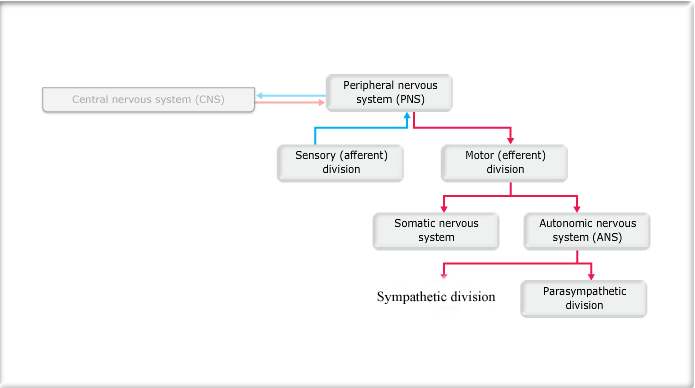
...
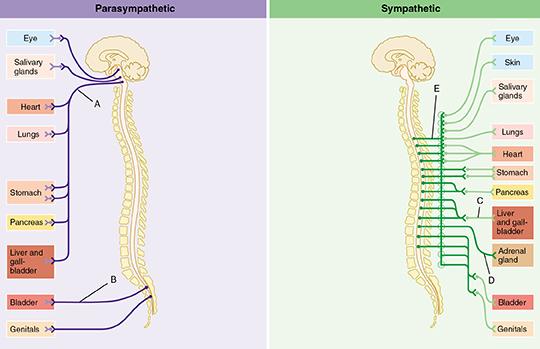
Outflow of the sympathetic division occurs from which regions of the CNS?
- cervical and lumbar
- thoracic and lumbar
- cranial and sacral
- cranial only
- thoracic and lumbar
- Preganglionic fibers of the sympathetic division arise from the thoracic and upper lumbar regions (T1 to L2) of the spinal cord.
Which of the following is NOT associated with the parasympathetic division of the autonomic nervous system (ANS)?
- resting
- energy conservation
- emergency action
- digesting
- emergency action
- The activity of the sympathetic division, often called the "fight-or-flight" system, is evident when we are excited, exercising, or find ourselves in emergency situations.
Unlike the sympathetic division, the parasympathetic division synapses with the adrenal medulla.
- True
- False
- False
- The sympathetic division synapses at the adrenal medulla which enhances the sympathetic responses.
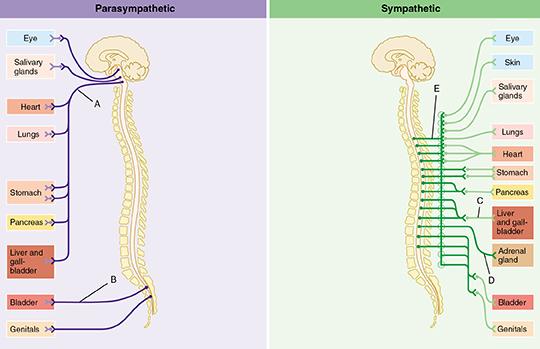
Which of the following statements is true of the group of fibers indicated by the letter D?
- D indicates fibers that stimulate the release of acetylcholine into the blood stream from the adrenal gland.
- D indicates fibers that mediate the long-lasting effects of the parasympathetic division.
- D indicates fibers that bypass collateral ganglia and terminate within the adrenal gland.
- All the listed statements regarding the fibers at D are correct
- D indicates fibers that bypass collateral ganglia and terminate within the adrenal gland.
- Unlike other preganglionic fibers of the sympathetic division, the particular fibers indicated by D pass through the celiac ganglion to the adrenal gland, where they stimulate the release of epinephrine and norepinephrine into the bloodstream.
Once a preganglionic axon reaches a trunk ganglion, one of three things can happen to the axon. Which of the following is NOT one of these three things?
- The axon can course back into the spinal cord to synapse with preganglionic neurons in a different spinal segment.
- The axon can pass through the trunk ganglion and emerge from the sympathetic trunk without synapsing.
- The axon can ascend or descend the sympathetic trunk to synapse in another trunk ganglion.
- The axon can synapse with a ganglionic neuron in the same trunk ganglion.
- The axon can course back into the spinal cord to synapse with preganglionic neurons in a different spinal segment.
- Preganglionic axons do not pass back into the spinal cord.
Which of the following is an effect of norepinephrine binding to beta 2 adrenergic receptors?
- vasodilation
- vasoconstriction
- an increase in heart rate
- lipolysis
- vasodilation
- The binding of norepinephrine to the beta 2 adrenergic receptors in blood vessels causes vasodilation.
What differentiates an autonomic reflex from a somatic reflex?
- an integration center
- a two-neuron motor pathway
- presence of a sensory receptor
- a single sensory neuron in the sensory pathway
- a two-neuron motor pathway
- Visceral reflex arcs have essentially the same components as somatic reflex arcs--receptor, sensory neuron, integration center, motor neuron, and effector. A key difference is that a visceral reflex arc has two neurons in its (autonomic) motor component, whereas the somatic reflex arc has a single (somatic) motor neuron.
The sympathetic division innervates targets with nerves that all originate from the thoracolumbar region.
- True
- False
- True
- The sympathetic division is also called the thoracolumbar division of the autonomic nervous system because the thoracic and upper lumbar spinal segments contain the cell bodies of all preganglionic sympathetic neurons.
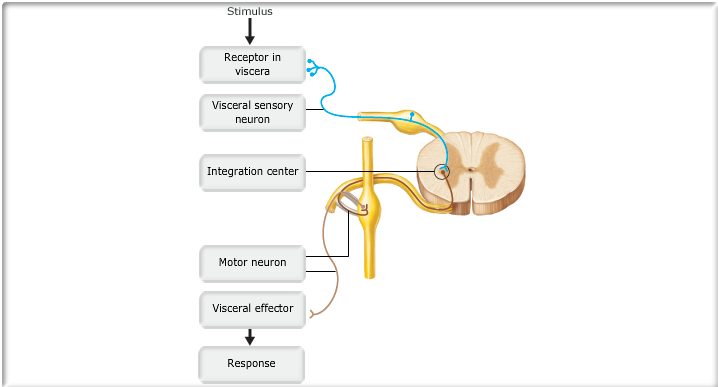
...
Which of the following is characteristic of the parasympathetic division?
- inhibited digestion and elimination
- increased heart rate
- dilated airways
- stimulates secretory activity
- stimulates secretory activity
- Secretory activity is controlled by the parasympathetic division of the autonomic nervous system
Symptoms of autonomic neuropathy could include any EXCEPT which of the following?
- diarrhea
- constipation
- abnormal stretch reflex responses
- hyposecretion by sudoriferous glands
- abnormal stretch reflex responses
- The stretch reflex is controlled by afferent sensory stretch receptors and somatic efferent motor neurons.
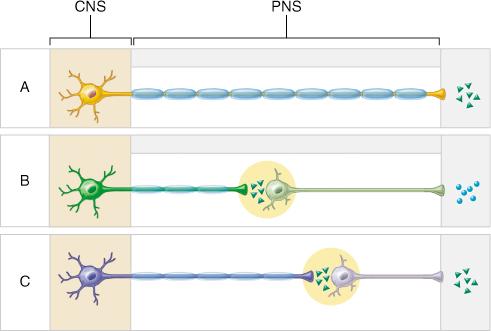
The circular structures shown within pathways B and C represent which of the following?
- tracts
- ganglia
- nuclei
- rami
- ganglia
- A collection of neuron cell bodies in the PNS is found within ganglion. Note that the ganglia of the sympathetic division are located nearer to the spinal cord, and the ganglia of the parasympathetic division are located nearer to (or within) target organs.
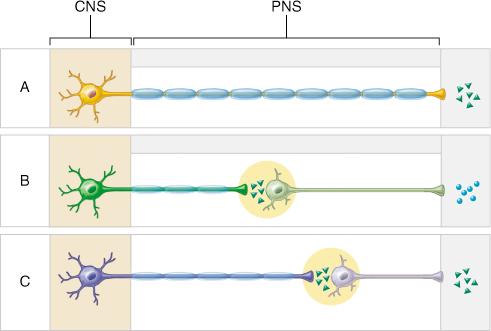
Which of the following releases the neurotransmitter norepinephrine?
- terminus of a parasympathetic postganglionic neuron
- terminus of a sympathetic preganglionic neuron
- terminus of a sympathetic postganglionic neuron
- terminus of a somatic motor neuron
- terminus of a sympathetic postganglionic neuron
- Release of norepinephrine at synapses within effector organs is characteristic of the sympathetic division (B).
Why would smooth muscle associated with lung bronchioles dilate while smooth muscle associated with arterial walls constricts when stimulated by norepinephrine neurotransmitter?
- different receptor types
- different target organs
- different smooth muscle
- different body systems
- different receptor types
Nasal decongestants phenylephrine and pseudoephedrine act to shrink dilated blood vessels in the nasal passages to relieve congestion. They are called sympathomimetics because they act similar to sympathetic neurotransmitter norepinephrine. Which of the following would be an undesirable side effect associated with their use?
- nervousness
- muscle aches
- arm numbness
- drowsiness
- nervousness
Which description is NOT consistent with the sympathetic division?
- long postganglionic fibers
- ganglia close to the spinal cord
- thoracolumbar
- most innervation from the vagus nerve
- most innervation from the vagus nerve
- The vagus nerve innervates most of the parasympathetic division.
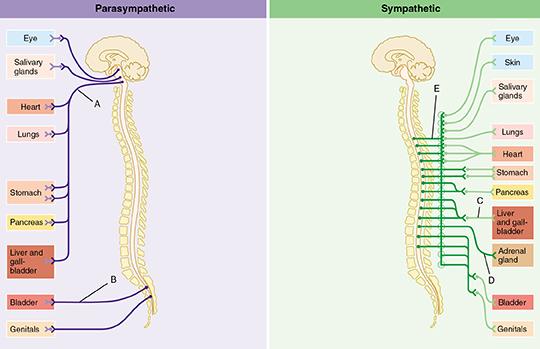
Which of the letters in the figure indicates the vagus nerve?
- A
- B
- C
- D
- A
- The vagus nerve (cranial nerve X) is a component of the parasympathetic cranial outflow and controls normal function of organs of the thoracic and upper abdominal cavities.
Which target organ is NOT affected by the parasympathetic division of the autonomic nervous system (ANS)?
- adrenal medulla
- liver
- heart
- lungs
- adrenal medulla
- The adrenal medulla is not innervated (thus not affected) by the parasympathetic division of the ANS. Preganglionic sympathetic fibers stimulate the adrenal medulla to secrete epinephrine and norepinephrine (hormones that contribute to the overall fight-or-flight response mediated by the sympathetic division of the ANS) into the bloodstream.
Which of the following is NOT a designation for sympathetic ganglia?
- trunk ganglia
- terminal ganglia
- prevertebral ganglia
- collateral ganglia
- terminal ganglia
- Parasympathetic ganglia are also called terminal ganglia because they lie close to or within the target organs.
The adrenal medulla secretes epinephrine during sympathetic stimulation. Which of the following statements describes why epinephrine would increase the sympathetic response?
- Epinephrine increases the action of pre- and postganglionic axons.
- The same receptors that respond to norepinephrine also respond to epinephrine, increasing the action of both.
- Epinephrine has no effect on sympathetic targets.
- Epinephrine binds to a separate receptor than norepinephrine, which increases the sympathetic response.
- The same receptors that respond to norepinephrine also respond to epinephrine, increasing the action of both.
- There is no separate receptor for epinephrine. It enhances the sympathetic pathways because it binds to the same receptors as norepinephrine.
Which set of details correctly identifies a series of events in a sympathetic pathway?
- craniosacral origin, short preganglionic fiber, ACh release at ganglion, long postganglionic fiber, ACh release at effector
- thoracolumbar origin, long preganglionic fiber, NE release at ganglion, short postganglionic fiber, NE release at effector
- craniosacral origin, long preganglionic fiber, ACh release at ganglion, short postganglionic fiber, ACh release at effector
- thoracolumbar origin, short preganglionic fiber, ACh release at ganglion, long postganglionic fiber, NE release at effector
- thoracolumbar origin, short preganglionic fiber, ACh release at ganglion, long postganglionic fiber, NE release at effector
- This describes the pathway for a sympathetic response.
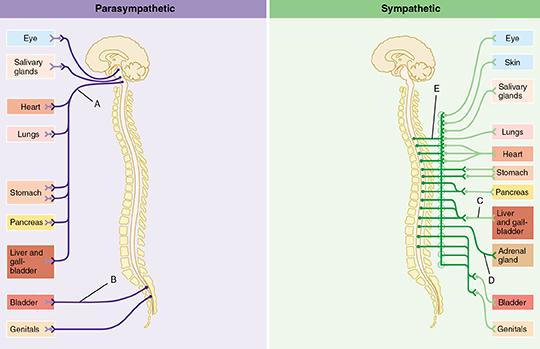
Which organ receives major input from the sympathetic, but not parasympathetic, division?
- bladder
- heart
- skin
- salivary glands
- skin
- The smooth muscle of dermal blood vessels and arrector pili are innervated by the sympathetic, but not parasympathetic, division.
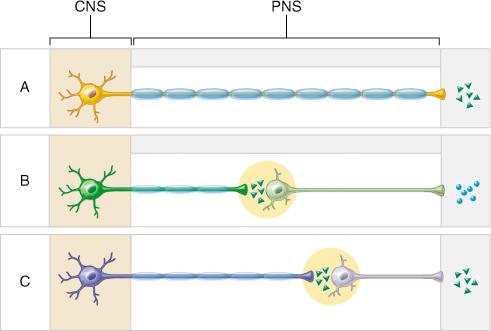
Which pathways compose the autonomic nervous system?
- A only
- B only
- C only
- B and C
- B and C
- The outflow of the ANS is characterized by a two-neuron chain spanning from CNS to the effector organ. Both B and C show such an arrangement consisting of both pre- and postganglionic neurons.
Which plexus does NOT receive innervation from the vagus nerve?
- pulmonary plexuses
- abdominal aortic plexus
- cardiac plexuses
- inferior hypogastric plexus
- inferior hypogastric plexus
- The inferior hypogastric plexus receives nerve fibers from the pelvic splanchnic (spinal) nerves, not the vagus (cranial) nerve. As the vagus nerves pass into the thorax, they send branches to the cardiac, pulmonary, and esophageal plexuses. In the abdominal cavity, they send fibers through the large abdominal aortic plexus.
Which of these activities is most likely driven by parasympathetic innervation?
- sweating and dilating pupils
- resting and digesting
- vigorous physical activity
- fight-or-flight responses
- resting and digesting
- The parasympathetic division, sometimes called the "rest and digest" system, keeps body energy use as low as possible, even as it directs vital housekeeping activities like digesting food and eliminating feces and urine.
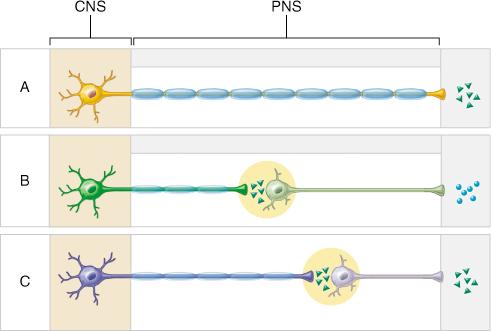
Which of the following best describes the effect on the heart of neurotransmitters released from the postganglionic neurons of B and C?
- B and C would act in synergy to decrease heart rate and contraction force.
- B and C would act in synergy to increase heart rate and contraction force.
- B would increase heart rate, while C would decrease it.
- C would increase heart rate, while B would decrease it.
- B would increase heart rate, while C would decrease it.
- Sympathetic stimulation would increase heart rate, when under stress, while parasympathetic stimulation would decrease heart rate, during “rest and digest.”
Which of the following is NOT an autonomic nervous system (ANS) function?
- increasing heart rate
- reflex of skeletal muscle
- gland secretion
- emptying the bladder
- reflex of skeletal muscle
- The somatic nervous system stimulates skeletal muscle, whereas the ANS innervates cardiac muscle, smooth muscle, and glands.
Which receptor paring below is correct?
- muscarinic: norepinephrine
- alpha 1: acetylcholine
- nicotinic; acetylcholine
- nicotinic: norepinephrine
- nicotinic; acetylcholine
- Nicotinic receptors are one of two acetylcholine receptors.
Which of the following target organs/systems is affected by the sympathetic nervous system but is NOT affected by the parasympathetic nervous system?
- cellular metabolism
- lungs
- salivary glands
- gallbladder
- cellular metabolism
- Preganglionic sympathetic fibers stimulate the adrenal medulla to secrete epinephrine into the bloodstream during "fight-or-flight" situations (such as exercise). In turn, epinephrine increases cellular metabolism (metabolic rate).
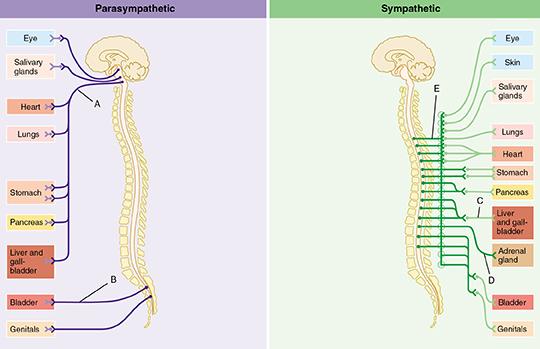
Where are ganglia of the parasympathetic division located
- within the medullas of endocrine glands
- in chains on either side the spinal column
- near major arteries just as they exit the aorta
- in or near effector organs
- in or near effector organs
- Note the location shown in the figure of synapses between preganglionic and ganglionic fibers on the left side of the figure that summarizes the outflow of the parasympathetic division.
Which of the following is an effect of norepinephrine binding to beta 2 adrenergic receptors?
- an increase in heart rate
- vasoconstriction
- vasodilation
- lipolysis
- vasodilation
- The binding of norepinephrine to the beta 2 adrenergic receptors in blood vessels causes vasodilation.
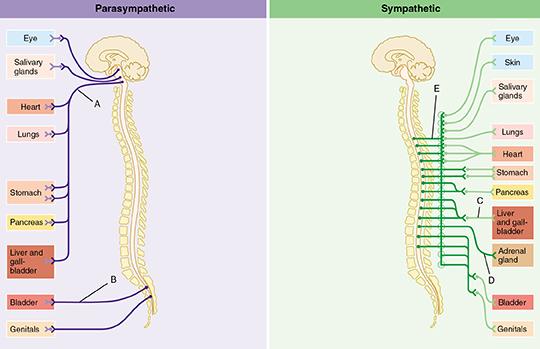
The group of fibers indicated by E represents which of the following?
- ventral ramus
- white rami communicantes
- splanchnic nerves
- dorsal ramus
- white rami communicantes
- The white rami communicantes connect preganglionic fibers from the spinal cord to the sympathetic trunk.
Which of the following is NOT a designation for sympathetic ganglia?
- prevertebral ganglia
- trunk ganglia
- collateral ganglia
- terminal ganglia
- terminal ganglia
- Parasympathetic ganglia are also called terminal ganglia because they lie close to or within the target organs.